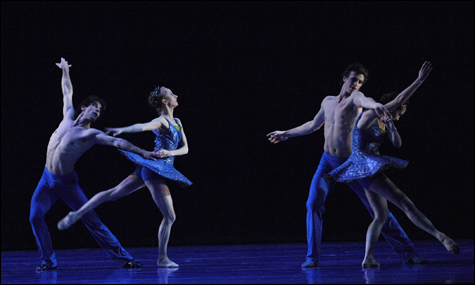
IN ON BLUE: Obsessing with Bernard Herrmann.
|
|
“Next Generation” | Eventide: Music by Michael Nyman, Jan Garbarek, and Philip Glass; Choreography by Helen Pickett; Costumes by Charles Heightchew | Gone Again: Music by Franz Schubert; Choreography by Heather Myers; Costumes by Heather Myers with Charles Heightchew | Ein Von Viel: Music by Johann Sebastian Bach; Choreography by Sabrina Matthews; Costumes by Carolyn O’brien | In On Blue: Music by Eugène Ysaÿe and Bernard Herrmann; Choreography by Jorma Elo; Costumes by Charles Heightchew | Lighting by Mark Stanley | Presented by Boston Ballet at the Wang Theatre through March 16
|
“Next Generation” is the kind of ballet-program title that might have you asking yourself what happened to “This Generation” — i.e., the American choreographers that wowed (some of) us in the ’80s, Mark Morris, Twyla Tharp, Paul Taylor, Bill T. Jones. They in turn seem a long way removed from the generation or two before them — Martha Graham, Agnes de Mille, Antony Tudor, Frederick Ashton, Merce Cunningham, Jerome Robbins, Alvin Ailey, to say nothing of Balanchine — and their best work seems mostly behind them. In their place we have the variously prepossessing Christopher Wheeldon, Peter Martins, Alexei Ratmansky, and Matthew Bourne. Boston Ballet’s “Next Generation,” which it presented last weekend at the Wang Theatre, offered three world premieres and one American premiere by four protégés of Boston Ballet artistic director Mikko Nissinen: Helen Pickett, Heather Myers, Sabrina Matthews, and Jorma Elo. It was a kinetic evening notable more for the contributions of the dancers than for the pieces’ concepts or their choreography, or the lighting.
Speaking to the audience at curtain time (live on opening night, recorded thereafter), Mikko Nissinen noted that it’s unusual to have three world premieres on a single program, and unusual to have three women choreographers on a single program. Even more unusual was the opening amuse-gueule, a 10-minute work called Téssera (the number four in Greek, but also an individual tile in a mosaic) that Jorma Elo “arranged” for the four still-young choreographers, to a snatch of Sibelius (a loop of the galloping four-bar ostinato for lower strings and timpani that kick-starts the finale of the Violin Concerto). The curtain rose to reveal the quartet running on and lining up with their backs to us and half turning around. They moved in unison, or in sequence, before breaking into solos that varied from one night to the next. Myers seemed to be about balancing and creating space with her arms. Elo, in between pauses for reflection, was beset by a swarm of mosquitoes (or the Furies); I had the vague impression he was quoting from the history of dance. Pickett did more with her feet, kicking and walking, before going to ground; Matthews alternated between channeling a good-natured mastiff and getting pulled about by one. They were united in their need to keep moving and in their isolation from one another.
That was the theme of the rest of the program, along with oblique lighting by Mark Stanley that blurred identities and kept you at a distance. (Alastair Macaulay in his Monday New York Times review of the program described Stanley as belonging to the lighting “School of [William] Forsythe.”) A triptych to music by Michael Nyman (Compiling the Colours: Samhitha, from Sangam: Michael Nyman Meets Indian Masters), Jan Garbarek (his Madar album), and Philip Glass (Meetings Along the Edge, from the Ravi Shankar collaboration Passages), Helen Pickett’s Eventide set five couples against a backdrop of 10 corps women. Pickett, a former dancer with Forsythe’s Ballett Frankfurt, choreographed the more focused Etesian for Boston Ballet in 2005. She describes Eventide as “an ode to a few special people that have been a part of my life and an ode to dance itself,” citing among her inspirations e.e. cummings and Edward Hopper.
The second part, to a smoky saxophone-and-oud duet by Jan Garbarek and Anouar Brahem, could have suggested Hopper’s Nighthawks, but I have no idea how cummings came into the piece, which seemed overconceptualized and underchoreographed. Or perhaps it was the music — watching Lorna Feijóo in the first part Thursday, I kept thinking how much better she’d have looked doing the same kind of steps in Balanchine’s Rubies or Who Cares? That first part found the corps women dressed in powder-blue leotards and long slit metalic skirts and the couples in what looked like gray Greek armor, the ladies with pleated red tail skirts. The “set” was a pair of long red curtains dropping from overhead and pooling on the floor, like blood, before rising near the end. There are four contrasting duets in this part, with one couple sinuous and sexy, one jazzy, one lyrical, etc. Kathleen Breen Combes was explosive in her opening solo Thursday; Rie Ichikawa, dancing now with increasing self-confidence, was delicately pointed but not less sensual in the same part Saturday afternoon, and she had an expansive, Atlas-like partner in Sabi Varga. A demonic Yury Yanowsky, dancing with Feijóo on Thursday, brought a sense of danger to the second couple, and Melanie Atkins teased with her pelvis and long legs Saturday in her lyrical duet with Boyko Dossev.